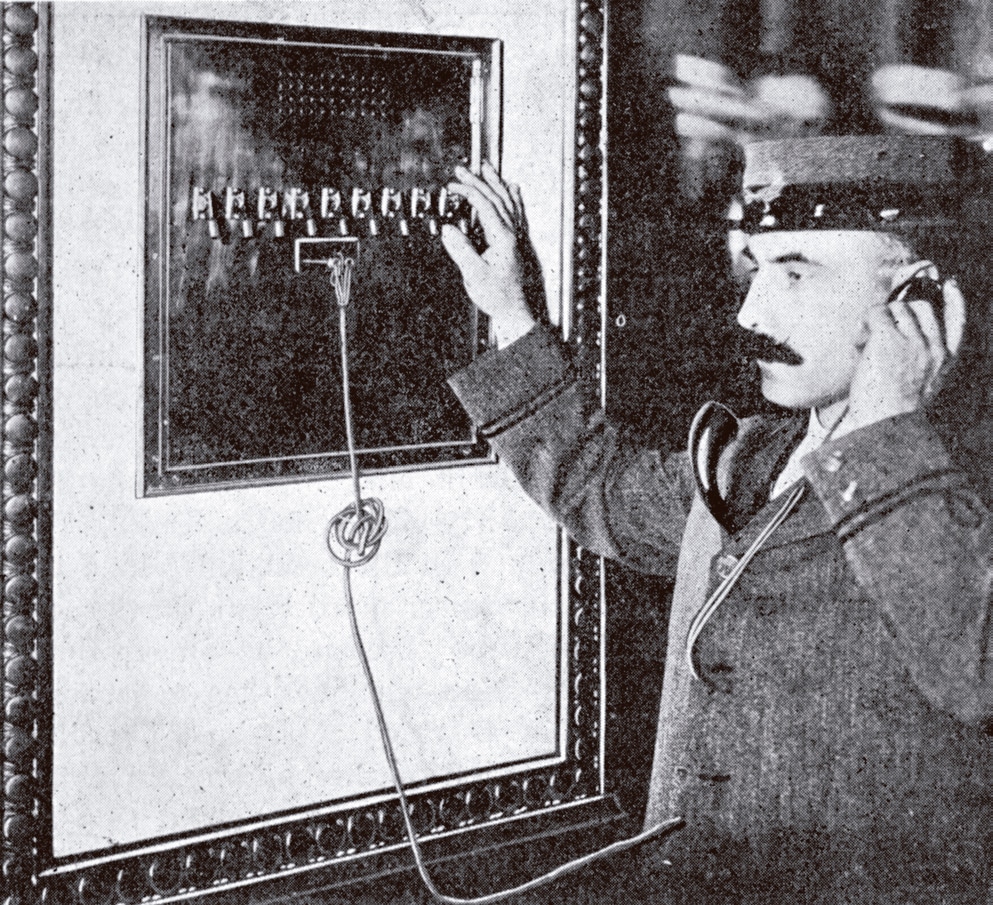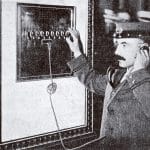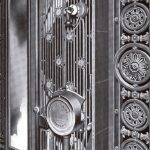Elevator Telephony
Nov 1, 2016

Historical evidence for the first use of elevator telephones is examined.
The 1908 Singer Building in New York City is often identified as the first building in the U.S. to employ telephones in elevator cars. The sources used to corroborate this claim include “Loud Speaking Telephones for Elevator Operation,” which was published in the August 8, 1908, issue of Electrical World. The article claimed that the Singer building represented the “first instance of a complete installation of a telephone system designed specially for elevator operation.”
Of course, all claims of a technological “first” require close scrutiny. In this case, the author clearly states that this was the first “complete installation” of a telephone system that was “designed specially” for elevator use. However, this statement also implies there may have been prior installations of telephone systems in elevators that were not “designed specially” for use in elevators. The possible existence of earlier, less complete systems also implies a progression from a true “first use” to the more refined system found in the Singer Building. This is, in fact, exactly what appears to have happened.
The June 24, 1899, issue of the Western Electrician featured an article on “interior telephone systems” designed and installed by Schmidt & Bruckner Electric Co. of New York. The article included a reference to one of the company’s recent “special” installations: “A novelty in the use of telephone apparatus is the equipment of the elevators of the Park Row building, New York, with telephones connected to switchboards in the engine room.” The July 1, 1899, issue of the Electrical World and Engineer carried a similar article, which added, “This service gives direct and instantaneous communication in case of trouble in the service of the elevators.” The Park Row Building, designed by R.H. Robertson and completed in 1899, was the tallest building in the world from 1899 to 1908 (391 ft./118.9 m). The building employed 10 elevators designed by Frank Sprague and Charles R. Pratt and marked the only installation of the vertical version of their famous electric screw-driven elevator. Given Sprague and Pratt’s interest in developing innovative elevator systems, it is possible they encouraged the use of telephones to aid in the efficient operation of the building’s elevators.
However, while these articles offer proof that the Park Row Building’s elevators featured telephones in 1899, they do not answer the question concerning the first use of this technology. This question was, perhaps, answered in an article published in the March 8, 1902, issue of American Telephone Journal. The article, “Elevator Telephone Service,” was written by H.M. Reynolds, Superintendent of the Park Row Building. Reynolds described the system and its operation as follows:
“The Park Row Building enjoys the distinction of being the only one in which can be found the practical application of what may be termed aerial telephony. A conspicuous feature of the equipment of the building’s great system of vertical transportation, whose passengers are daily numbered by tens of thousands, is the installation in each of the 10 elevator cars in constant service of a telephone, by means of which instant communication may be had with the ground during the whole period of the journey into the air and down again through the 30-odd stories of the structure.
“In case of the derangement of any portion of the mechanism of a car, the operator has merely to touch a button, which rings an alarm in the engineer’s office in the basement and registers the number of the disabled car on a switchboard; telephonic communication is then at once established, and no time is lost in locating the fault in the elevating mechanism and making the necessary repairs. It is rare that it is necessary to have recourse to the telephones, but the fact of their presence adds not a little to the sense of security to multitudes who daily make use of the elevator service.”
This description serves as reminder that early telephone systems relied on an operator to facilitate the connection between phones. It is of interest to note that this description only addresses communication from the cars to the building’s engineer, and it appears to have been viewed only as an emergency system. Reynolds also attempts to give the Park Row Building pride-of-place in this story with his description of the building as “the only one in which can be found the practical application of what may be termed aerial telephony.” Of course, his account also employed a careful use of words, claiming that the building offered the first “practical application” of this communications technology. Thus, another contender for the first use of elevator telephones may still be awaiting discovery.
The use of elevator telephones in the Park Row building did not, however, launch a wave of telephone installations in office buildings. The period between 1899 and 1908 witnessed a gradual, and occasionally intriguing, expansion of telephone use in elevators. The growth of personal telephone use in the early 20th century did not always, given the associated expense, result in the widespread availability of telephones. This fact is illustrated by the innovative use of an apartment building elevator, recounted in the March 1905 issue of The Electrical Age:
“An old studio building in the city of New York, built many years ago, has the next-best thing to having a telephone service in each apartment. Instead of tenants being obliged to go down to the ground floor to answer calls, the telephone is brought up to them in the elevator. This is done simply by fixing the regular telephone instrument to the wall of the car and having enough wire to spare to allow the elevator to move up and down with it. The elevator boy answers the calls and simply moves his elevator to the floor where lives the person desired. The tenants in the building have gotten used to it and seem to have no trouble in carrying on conversations, while the elevator goes up and down on its business.”
The prospect of an apartment dweller happily carrying on a personal conversation while standing next to the elevator operator — and possibly other passengers — in the close confines of the elevator car is intriguing. (Perhaps the contemporary equivalent is the oblivious passenger who continues to talk on his or her cell phone during an elevator ride.)
A different application of what was often referred to as “elevator telephony” occurred in the context of the large urban hotel. The November 1907 Michigan State Gazette reported:
“The Congress Hotel Co., proprietors of the Auditorium and the Auditorium Annex Hotels, has equipped their elevators in both houses with private branch exchange terminals connected with the hotel system. This installation is the first of its kind west of New York, where some of the largest hotels first inaugurated this system.”
The phrase “private branch exchange” refers to the creation of a telephone system designed solely for in-house communications. The reference to earlier hotel installations in New York is also intriguing, however. Thus far, the first hotel with elevator telephones has not been identified. An article that appeared in the July 4, 1908, American Telephone Journal discussed the new system in the Hotel Astor in New York and offered a more thorough description of a hotel private branch exchange:
“In the basement, in the engineer’s office, is located a 90-line mahogany switchboard. It has three trunk lines to the central office and five trunk lines to the main switchboard. It has 45 extensions connected to it and handles calls from various service departments, thus relieving the main switchboard of a large number of calls. All the elevator cars in the hotel are equipped with telephones connecting with this switchboard. These telephones are used for giving orders to, or communicating with, different departments, while a person is going from floor to floor.”
This description implies that the elevator telephones were primarily intended to facilitate constant communication between the hotel’s management and staff. A hotel manager could, while on the elevator, contact the front desk to resolve a problem or contact the restaurant to confirm the arrival of important guests. If this assessment of the application of these elevator telephones is correct, it represents a very different concept of the utility of this new technology.
The completion of the Singer Building in 1908 resulted in a new world’s tallest building (612 ft./186.6 m), as well as a new paradigm in elevator telephones. The system was designed to facilitate communication between the starter (the person charged with maintaining efficient elevator traffic), elevator operators, the building engineer and the building watchman. Although the system employed a switchboard located in the basement to manage communication between the elevator cars and other points in the building, the starter had the ability to independently contact the elevator cars. This operation depended on an enhancement that resulted in a telephone system “designed specially for elevator operation.” Indeed, the title of the Electrical World article “Loud Speaking Telephones for Elevator Operation” hints at the use of something beyond a normative telephone and prompts the question, “What was a loud–speaking telephone?”
If the starter wanted to communicate with an elevator operator, he would go to a communications panel located in the hallway. There, he would plug a portable telephone headset into the jack corresponding to the car he wished to communicate with and then flip a switch to initiate the call (Figure 1). However, activating the switch would not cause the elevator telephone to ring. Instead, it would activate the car’s loud-speaking telephone. This was essentially a large-scale version of a normal telephone receiver (Figure 2). This system allowed the operators to “hear the orders transmitted to them by the starter without placing the receivers to their ears or otherwise interfering with their work.” The receivers were described as “specially designed for use in the elevator cars,” having been “modified to secure an unusually loud and clear enunciation.”
The cars also featured a call button that allowed the operators to signal the starter. When they pushed the button, a bell would ring in the starter’s communication panel alerting him to the need to contact the car. The loud-speaking telephone was located above a wall-mounted telephone that allowed operators to obtain a secure “connection through the private-exchange switchboard in cases of emergency” (Figures 3 and 4). Henry C. Buxton, the Singer Building’s chief engineer, claimed “it would be impracticable to operate the elevators without such equipment.” Electrical World proclaimed: “Another large field of application has been found for the ubiquitous telephone, especially if, as seems likely, very tall buildings increase in number and become the rage.” The Singer Building appears to mark the first appearance of this unique two-part communication system, and it established a pattern followed into the early 1920s.
A final aspect of the introduction of the elevator telephone is the incorporation of this new technology into elevator safety codes. The first two editions of the A17 code contained no mention of telephones in elevator cars. The third edition (1937) included the following rule:
“Rule 231 Emergency Signal
- “a. Automatic operation elevator shall be provided with an audible emergency signal that is operative from the car and located outside of the hoistway, or shall be provided with a telephone.
- “b. Unless provided with a telephone permanently connected to a central exchange, power elevators which do not require the presence of an elevator operator shall only be operated when there is an engineer, electrician, or janitor on the premises continuously during such operation. The emergency alarm required in paragraph a. shall be clearly audible in the office, power house, or room in which such employee is ordinarily located.”
While the rule allows the operation of cars without telephones, it marks the first instance in the A17 code, in which the elevator telephone is seen as a component of an emergency communications system. This definitive “first” allows this article to, perhaps, conclude on slightly firmer ground than whence it began.
- Figure 1: Starter’s communication panel, Singer Building, 1908
- Figure 2: Loud-speaking telephone, 1908
- Figure 3: Elevator car equipped with loud-speaking and wall-mounted telephones, Singer Building, 1908
- Figure 4: Elevator car equipped with loud-speaking telephone and wall-mounted telephone, Singer Building, 1908
Get more of Elevator World. Sign up for our free e-newsletter.













